Introduction to Artificial Intelligence Syllabus
We will learn about the Artificial Intelligence Syllabus in this article. What does the artificial intelligence syllabus include? What should be an artificial intelligence syllabus? In this article, we will see the hierarchy of artificial intelligence. Artificial Intelligence’s major objective is to create systems that can work intelligently and independently. Artificial intelligence (AI) is a major subfield in computer science.
Artificial Intelligence (AI) refers to systems or robots that mimic human intellect in order to accomplish tasks and may iteratively improve themselves depending on the data they collect. AI may take many different shapes. Chatbots, for example, employ AI to better comprehend client concerns and give more efficient responses. This article on the artificial intelligence syllabus will help you understand what to read and what you can expect to learn.
Artificial Intelligence Syllabus
To put it another way, AI encompasses anything that allows a computer to function very much like human brains, except without emotion. Again, this is science fiction, and it is a long way off from anything we can do now. Thus Machine Learning is the field of AI concerned with extracting patterns from large data sets. This implies the computer can not only identify optimum behavior norms but can also adapt to changes in the environment and learn. This means that machines can identify rules in subject matter when manual rule generation is either prohibitively expensive or impossible. Let’s get started with the artificial intelligence syllabus. Artificial Intelligence is categorized into 2 parts:
- Robotic Process Automation
- Cognitive Computing
This should be part of the artificial intelligence syllabus and it is important to learn the artificial intelligence syllabus.
You can also Read related topics:- Data Science & Artificial Intelligence
Robotic Process Automation
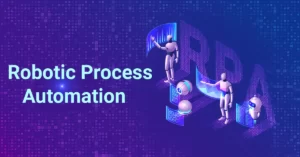
RPA, also known as software robotics, uses automation technology to replicate back-office functions performed by humans, such as extracting data, filling out forms, transferring files, and so on. It integrates and performs repetitive operations between corporate and productivity apps via APIs & user interface interactions. RPA solutions automate the execution of various tasks and transactions across disparate software systems by deploying scripts that mimic human operations.
AI is seen as a sort of technology that can replace human labor and automate end-to-end operations. RPA is utilized to work alongside humans by automating repetitive procedures. AI utilizes unstructured inputs and develops its own reasoning, whereas RPA uses organized inputs and logic. A fully autonomous process may be created by combining RPA and artificial intelligence. Many processes require a combination of RPA and AI to automate a process from beginning to end, or to optimize robotics once it has been deployed because businesses contain both organized and unstructured data.
That’s why it’s important to learn RPA and should be included in Artificial Intelligence Syllabus.
Cognitive Computing
Computer Vision
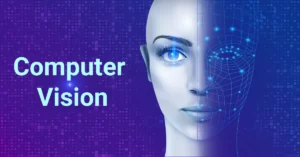
Computer vision is a subset of artificial intelligence (AI) which thus allows computers and systems to extract useful information from digital photos, videos, and other visual inputs, and to conduct actions or make suggestions based on that data. If artificial intelligence allows machines to think, computer vision allows them to see, watch, and comprehend. Human vision is similar to computer vision, however, humans have an advantage. Human vision benefits from lifetimes of context to teach it how to distinguish objects apart, how much further away they are, if they are moving, and whether something is incorrect with a picture.
Computer vision teaches computers to execute these tasks, but using cameras, data, and algorithms rather than retinas, optic nerves, and a visual brain, it must do so in much less time. Because a machine trained to check items or monitor a production asset may evaluate hundreds of items or processes per minute, detecting faults or issues that are invisible to humans, it can swiftly outperform human skills.
A lot of data is required for computer vision. It repeats data analyses until it detects distinctions and, eventually, recognizes pictures. To teach a computer to recognize automotive tires, for example, it must be fed a large number of tire photos and tire-related materials in order for it to understand the distinctions and recognize a tire, particularly one with no faults. Deep learning, a sort of machine learning, and convolution are two key technologies utilized to do this (CNN). Hence, it’s an important part of the Artificial Intelligence Syllabus.
Machine learning
Machine learning (ML) is a subset of artificial intelligence (AI) that allows the software to improve its accuracy in predicting the outcome without being explicitly programmed to do so. In order to forecast new output values, machine learning algorithms use past data as input. Machine learning is frequently applied to recommendation engines. Fraud detection, spam filtering, and predictive maintenance are just a few of the other common applications.
Machine learning is significant because it allows businesses to see trends in customer behavior and company operating patterns while also assisting in the creation of new goods. Machine learning is at the heart of many of today’s most successful businesses, like Facebook, Google, and Uber. For many businesses, machine learning became a crucial competitive differentiation.
Machine learning may be divided into three categories on a broader level:
- Supervised learning
- Unsupervised learning
- Reinforcement learning
Artificial neural networks
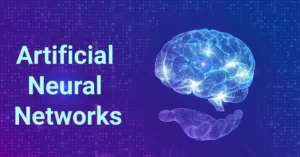
Artificial Neural Networks (ANNs) and simulated neural networks (SNNs) are types of neural networks that are used in deep learning techniques. Their name and architecture are inspired by the human brain, and they function similarly to biological neurons. Artificial Neural Networks (ANNs) are a form of learning algorithm artificial neural. That is, much like neurons in our central nervous can learn from previous data, the ANN may learn from data and respond in the manner of forecasts.
Nonlinear statistical models, or ANNs, demonstrate a complicated relationship between inputs and outputs in order to uncover a new pattern. Artificial neural networks are used for a range of applications including image identification, speech recognition, machine translation, and medical diagnosis.
Deep Learning
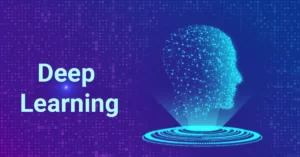
Deep learning is a machine learning approach that allows computers to learn by example in the same way that people do. Deep learning is a critical component of self-driving automobiles, allowing them to detect a stop sign or discriminate between a pedestrian and a lamppost. It enables voice commands in consumer electronics such as phones, tablets, televisions, and hands-free speakers. Deep learning has gotten a lot of press recently, and for good cause.
It’s accomplishing accomplishments that were previously unattainable. Therefore, it’s an important part of the Artificial Intelligence Syllabus.
Tools in Artificial Intelligence Syllabus
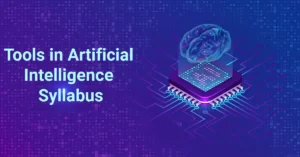
Artificial intelligence has made it easier to handle enormous amounts of data and put it to work in the industry. With the rise of AI and machine learning, the number of tools and approaches accessible to scientists and developers has expanded.
Tensorflow
If you work in the area of artificial intelligence, then have most certainly come across, attempted, or implemented some sort of deep learning computation. The exciting aspect of Tensorflow is that you can create a program in Python and have it operate either on your CPU or GPU. As a result, you don’t need to compose in C++ or CUDA to run on GPUs.
It makes use of a multi-layered hub architecture that allows you to quickly build up, train, and send fake neural networks with large datasets. This is the technology that allows Google’s voice-recognition software to identify queries in photos and understand audibly stated phrases. Therefore, it’s an important part of the Artificial Intelligence Syllabus.
Keras
is for you if you prefer the Python method of doing things. It’s a high-level neural network library that uses TensorFlow or Theano as its backend. Keras shines in all of them. It also has an abstract structure that may be readily adapted to other frameworks if necessary (for compatibility, performance, or anything). It is important to learn and should be part of the artificial intelligence syllabus.
PyTorch
The PyTorch Tutorial is appropriate for both beginners and experts. Our Deep Learning Tutorial covers all of the fundamental and advanced ideas of Deep Learning, including deep neural networks and image processing. PyTorch is a Python machine learning library based on Torch, which is a deep learning framework. This tutorial is set up in such a manner that we can quickly and simply create deep learning projects on PyTorch. Therefore, it’s an important part of the Artificial Intelligence Syllabus.
Natural Language Processing (NLP)
Natural language processing (NLP) is a science that focuses on helping computer algorithms understand natural human language. Natural Language Toolkit, or NLTK, is a Python library that may be used for NLP. Unstructured data with human-readable language makes up a large portion of the data you may be examining. You must first preprocess the data before you can examine it programmatically. This tutorial will provide you with an overview of the many types of text preparation tasks you may perform using NLTK so that you can use them in future work. You’ll also learn how to conduct some basic text analysis and visualize data.
You can skip a few tools while learning artificial intelligence but you can’t skip this topic. It is a must in the artificial intelligence syllabus.
NOTE: Click Here to know more about Data Science Artificial Intelligence
Conclusion
Artificial Intelligence is the future and no one can stop it. Artificial Intelligence has a bright future not only in India but also all over the world. In practically every major industry, such as agro, healthcare, education, infrastructure, transportation, banking, industrial, business, hospitality, and entertainment, technology is being utilized to develop smart answers to current challenges.
Artificial intelligence has the ability to transform every area of the economy for the greater good. Self-improving algorithms, computer vision, big data, and machine learning are just a few of the technologies that fall under the umbrella of AI. There will soon be no business or sector in India that is unaffected by this formidable weapon. This is why Artificial Intelligence courses are in high demand all over the world. I hope this article on the artificial intelligence syllabus will help you guide you and provide you with insights.
Frequently Asked Questions
Artificial intelligence has a bright future, with the Department of Labor estimating a 31.4% growth in jobs for data analysts and mathematical science experts, both of which are critical to AI, by 2030. Artificial Intelligence Syllabus also contains fascinating subfields like machine learning and computer vision, which is the process of training robots to perfect and enhance abilities on their own.
According to Forbes, machine learning occupations will be valued at $31 billion by 2024, representing a 40% increase in six years. AI also allows people to work across a range of industries and with cutting-edge technologies. Medical experts may use AI to detect and diagnose disorders. AI is used in transportation in the form of self-driving vehicles, companies utilize AI to crunch and evaluate performance data, and producers use AI to build equipment. The occupations are well paid, with an average annual base income of $125,000.
Is machine learning difficult to learn?
R and Python, which are both free and easy to install on your own computer, support a wide range of unsupervised and supervised models, and even simple models like logistic or regression models may be used to conduct fascinating and significant machine learning.
Although many sophisticated machine learning tools are difficult to use and require an extensive understanding of advanced math, stats, and computer engineering, novices may get a lot done with the fundamentals, which are freely available.
Artificial intelligence syllabus includes some math is required to grasp machine learning. Machine learning is built on the foundations of linear algebra, statistics, and probability. It’s time to brush up on your high school arithmetic if you’re serious about joining the machine learning bandwagon. Data analysis, in addition to arithmetic, is a necessary ability for machine learning.
Machine learning is built on the capacity to crunch data in order to draw relevant insights and patterns. The important phases in data analysis include loading a big data set, cleaning it to fill in missing data, and slicing and dicing the data set to uncover patterns and relationships. For more information read our blog on the Artificial Intelligence Syllabus.
Is artificial intelligence tough?
The idea of writing computer programs to make decisions on its own is known as artificial intelligence. This might range from detecting things in photographs to handling customer inquiries on behalf of the business. Machine learning is a subfield of artificial intelligence that trains computers to learn from data. This is accomplished by giving the computer a large number of instances and allowing it to find out patterns on its own.
Yes, it may be difficult, and 93 % of automation experts believe they are not well equipped for future problems in the area of smart machine technology. When it comes to deploying artificial intelligence syllabus, businesses confront several hurdles.
The greatest obstacle is a shortage of personnel capabilities, which affects 56 % of businesses. Given AI’s intrinsic complexity, it’s obvious that most businesses feel this way. For more information read our blog on the Artificial Intelligence Syllabus.
Can a fresher get a job in machine learning?
Obviously. If a fresher acquires the needed abilities, he or she can secure a machine learning job with this artificial intelligence syllabus. Freshers have to plan how they would perform effectively and work well with professionals who have significant expertise in the same subject to have a solid career in the artificial learning environment.
Is artificial intelligence the future?
Artificial intelligence is influencing the future of almost every sector and individual. This Artificial intelligence syllabus has functioned as the driving force behind developing technologies such as big data, robots, and the Internet of Things, and it will continue to do so for the foreseeable future.
Because this artificial intelligence syllabus is the cornerstone of computer learning, artificial intelligence is very crucial to our future. Computers can harness huge volumes of data and utilize their developed intelligence to make optimum judgments and breakthroughs in fractions of the time it takes people. Artificial intelligence is being credited with everything from cancer research advances to trying to cut global warming studies.
To work as a Machine Learning Engineer, you’ll need a few prerequisites mentioned in this artificial intelligence syllabus. Overall, this job includes reviewing and organizing data, running tests, and ultimately monitoring and optimizing the learning process in order to produce high-performing machine learning systems.
As a Machine Learning Engineer, you’ll be responsible for applying algorithms to various codebases, therefore software engineering expertise is ideal for this role. Essentially, the right mix of math, stats, and web development will provide you with the necessary foundation — once you understand these ideas, you’ll be ready to apply for Machine Learning jobs.
Even if you lack that background, you may pursue a job in machine learning by Artificial Intelligence Syllabus. To begin, you’ll need to learn about basic machine learning methodologies as well as the tools needed to create, operate, and optimize machine learning algorithms. Many people choose to enroll in a data science boot camp or a machine learning school to accelerate their learning and prepare for a career as a Machine Learning Engineer. In six easy steps, you can become a Machine Learning Engineer.
- Learn Python
- Take a machine learning class.
- Make your own machine learning project.
- Learn how to collect the proper information.
- Participate in a contest or join an online machine learning community.
- Apply for internships and jobs in machine learning.
What percent of jobs will AI replace?
According to the World Economic Forum’s Future of Jobs Report, AI-enabled machines will replace 85 million jobs by 2025. While that figure may leave you anxious, the same research claims that AI will produce 97 million new employment by 2025. You can get into this AI domain through this artificial intelligence syllabus.
How do I start a career in artificial intelligence?
The growing demand for skilled AI professionals compensates experts with good compensation and a great deal of flexibility you need to know about Artificial Intelligence Syllabus. With the correct experience, employees wanting variety might possibly leap from opportunity to opportunity. From 2019 to 2019, the Bureau of Labor Statistics predicts a 15% growth in computing and data research occupations, which includes artificial intelligence syllabus.
Since May 2020, the typical annual compensation for this position was $126,830, with the opportunity for higher pay in managerial positions. While there are many AI jobs available, breaking into the area may take some time. For organized study, networking, and credibility in the profession, several experts advocate completing a postgraduate degree. The value of a well-diversified portfolio, on the other hand, continues to rise. Prior programming or tech development experience might help an application become a new hire.
Many businesses favor candidates with a master’s degree or higher in computer science. Traditional education can give a solid foundation for a job in artificial intelligence. A postgraduate diploma also can help you approach AI with a new, well-rounded viewpoint. A solid portfolio and prior programming expertise may be sufficient in place of postgraduate education. However, many students will find that networking is simpler while they are in graduate school.
One of the most academic achievements in AI occupations is that of a research scientist. They pose fresh and inventive queries for AI to solve. They are specialists in a variety of AI areas, including mathematics, computer vision, machine learning, and statistics in the artificial intelligence syllabus.
Hiring companies want researchers with a broad understanding of computer perception, graphical modeling, supervised learning, and language processing. Measuring, parallel computing, cloud services, computer vision, and artificial intelligence knowledge are all advantageous. Research scientists are in high demand, earning an average of $99,800 per year.
Is coding necessary for artificial intelligence?
Yes, if you want to work in artificial intelligence or machine learning, you’ll need to know how to code as it is an important part of the Artificial Intelligence Syllabus. Machine learning is applied through coding, and programmers who know how to write that program will have a better understanding of how the algorithms function and will be able to better monitor and improve them.
C++, Java, and Python are the most common programming languages mentioned, although it may get much more detailed. When it comes to machine learning, programs such R, Matlab, and Prolog become essential the artificial intelligence syllabus is mentioned.













